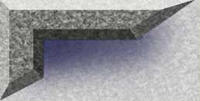|
Supermarine Spitfire
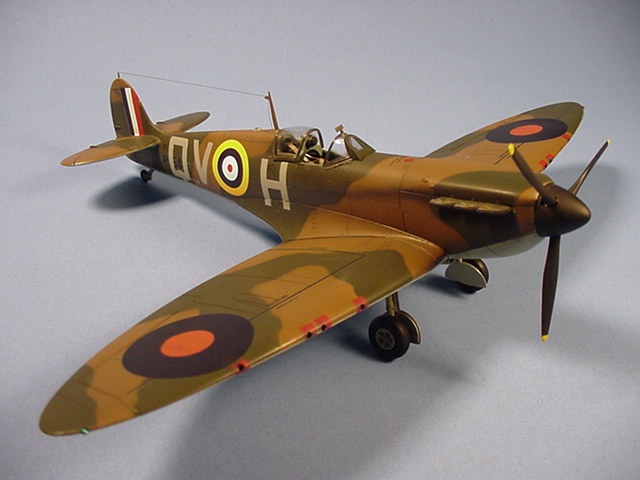
I guess I'd better start off the Spitfires with the Mark I... above and below we see Tamiya's 1/48th Spitfire Mk.
I in the No. 19 Squadron markings of P9546, flown by Flt. Sgt. George Unwin on September 7th, 1940. On that day, Unwin
was credited with downing two Bf109E's near Ramsgate and the Thames Estuary. Unwin would end the war with a commission
and 13-plus victories to his credit.
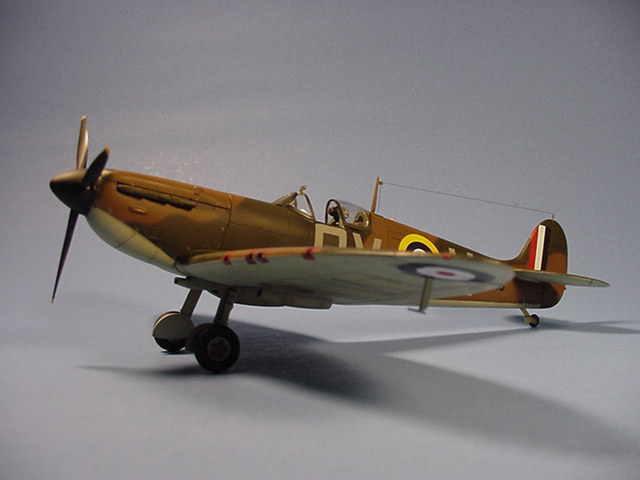
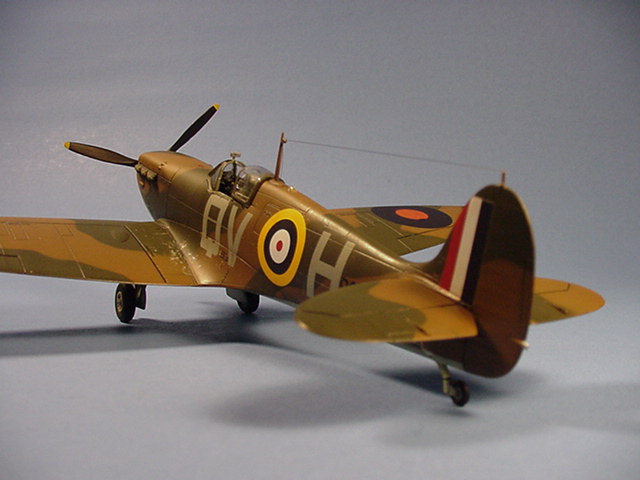
And another... here is the same kit, this time in the livery of a machine flown by FltLt. Richard Hillary, a native
son of Melbourne, Australia while assigned to 603 Squadron. Victorious over Bf109's in Spitfires L1021 and X4277 during
the Battle of Britain, 6 of his 8 successful combats were flown in the latter. On September 3rd, 1940 he destroyed a
Bf109E approximately 20 miles east of Margate and was set upon in turn by a 109 of II./JG26 and shot down over the Channel.
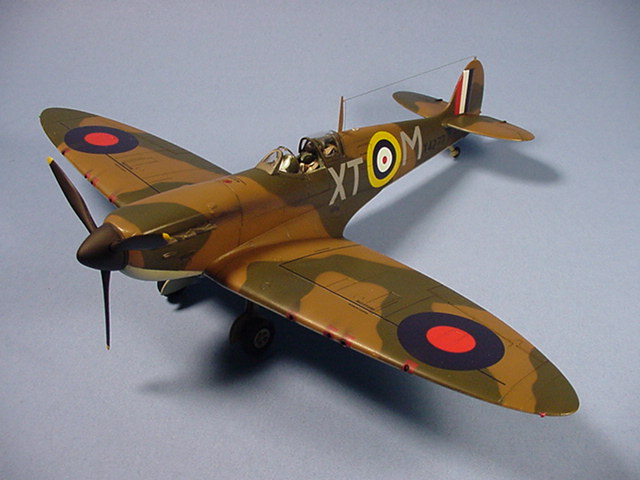
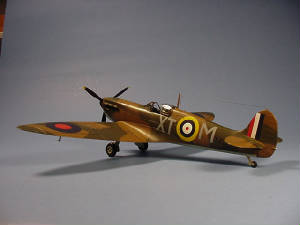
X4277 quickly became a blazing inferno and Hillary was burned severely prior to baling out, though he was later rescued.
After a long period of treatment by famed reconstructive surgeon Dr. Archibald McIndoe, and writing a book called The
Last Enemy during his recovery, FltLt. Hillary returned to operational flying in nightfighters in late 1942. Tragically,
he and his navigator lost their lives on January 8th, 1942 while on station flying a Blenheim in poor weather, the crash attributed
to ice buildup on the airframe.
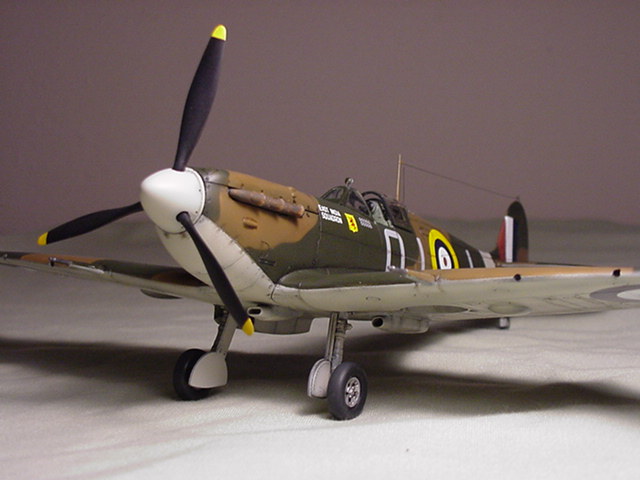
Above and below: Tamiya's Spitfire Mk. Vb, with just a few extras, finished
in the markings of Sq Ldr James Rankin's W3312 when he was commanding No. 92 Squadron at Biggin Hill during the summer
of 1941. Jamie Rankin was credited with 19 victories and survived the war. Cutting Edge GM-2 Reflector Gunsight
along with Ultracast propeller, spinner, and wheels. Decals from Victory Productions. Upper camoflage is Floquil British
Dark Green and Dark Earth, Sky underside is Modelmaster Russian Topside Gray, Radome Tan, and Flat White mixed at a 3:2:1
ratio.
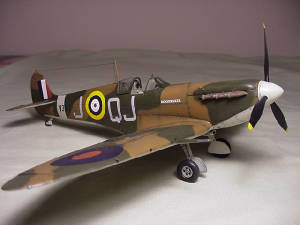 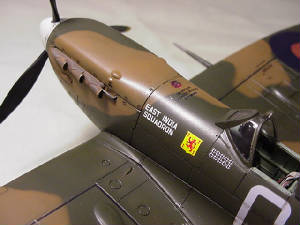 A very similar machine below. Model represents W3257 of No. 611 Squadron, flown by Flt. Lt. Eric Lock
during the summer of 1941 while based at Hornchurch. Nicknamed "Sawn Off" by his fellow pilots, Lock was
credited with 26 victories within the 11 months from August 15th, 1940 to July 14th, 1941- the lion's share consisting
of Bf109's. Eric Lock lost his life in air combat on August 3rd, 1941. Supermarine Spitfire Mk. Vb, 1/48th, again by
Tamiya, this time with Ultracast seat, wheels, propeller & spinner, exhausts, and flying control surfaces.
Decals from Victory Productions. Paints identical to those used on Rankin's "Moonraker".

American volunteer Flt.Lt. Carroll McColpin flew a Spitfire Mk.Vb with
No.71 (Eagle) Squadron, while based at North Weald in the summer of 1941. Later flying P-47s from Debden in the USAAC's
4th Fighter Group, McColpin brought his combined score to 8 or more victories. Exterior colors are Floquil RAF Dark Green,
Ocean Grey, and Medium Sea Grey beneath.

|
| Carrol McColpin's Spitfire Mk.Vb as represented by the 1/48th Hasegawa kit |

Wing Commander Stephan Witorzenc led the squadrons of the 1st Polish Wing over
the beaches of Dieppe on August 19, 1942. Virtually coinciding with the advent of Kurt Tank's new Fw190 fighter in squadron
strength, the air combat over the hotly debated Dieppe Raid was as fierce and uncompromising as ever. Fighters flying
in support of the Canadian landing forces had stripes painted over the nose in order to aid identification.
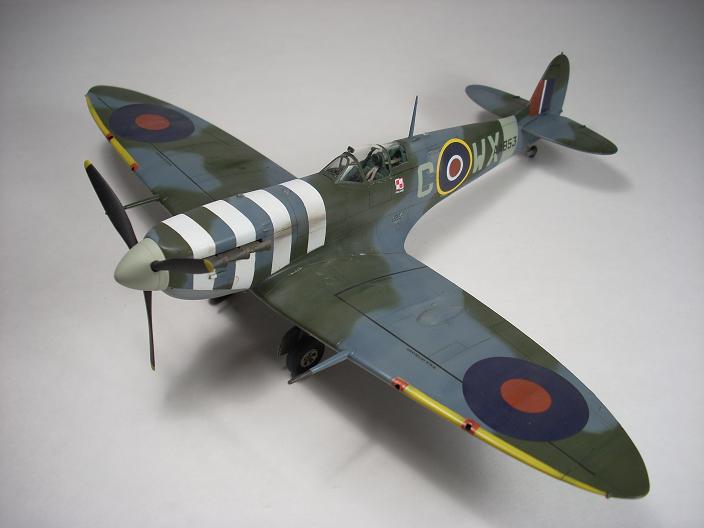
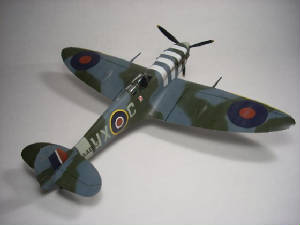
Wing Commander Witorzenc was credited 5+ victories and survived a very long war against Goering's Luftwaffe. This model
represents his machine while his wing was based at Kirton-in-Lindsay in the summer of 1942, but the stripes were temporarily
applied for the Dieppe Raid.
Next up is Hasegawa's 1/48th Mk.Vb bashed into a Mk.Vc to represent BR301, one of the planes flown by Sgt. George "Screwball"
Beurling while serving with No. 249 Squadron on Malta during the summer of 1942. On July 27th of that year, Beurling
downed two Macchi 202s, two Bf109s, and damaged a further two Bf109s in the defense of Malta. He used this aircraft
to down another Bf109 on the 29th, but after that his association with BR301 seems to have ended. By war's end Beurling
was credited with 31 destroyed, 1 shared destroyed, and 1 probably destroyed and a whole smattering of confirmed damaged that
could not be proven destroyed. Ending the war as a Flight Lieutenant, George Beurling lost his life in a takeoff accident
in the middle east on May 20, 1948.
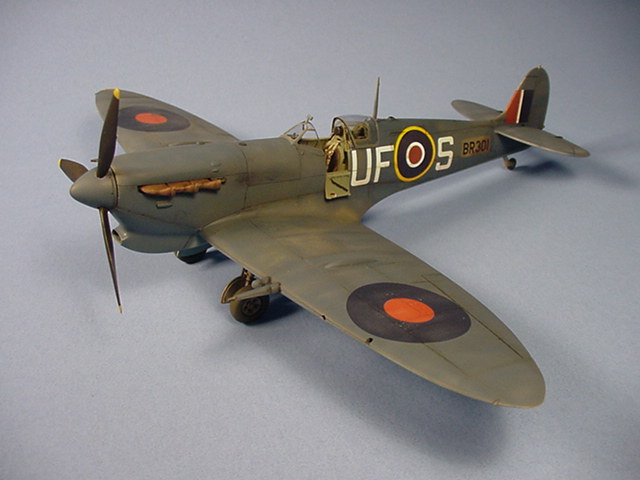
|
| Model was first paint in tropical land scheme, then overpainted in a custom-mixed blue gray |
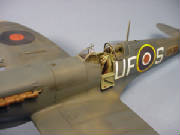
Decals are from Victory Productions "Aces of the Empire" set, except for the upper roundels which are from
Aeromaster. Wings were sanded and rescribed, gun bay hatch area removed and replaced with an Ultracast hatch. I also
used Ultracast's wheels, propeller, spinner, exhausts, cannons and stubs, pilot door, and seat. GM-2 gunsight is from
Cutting Edge.
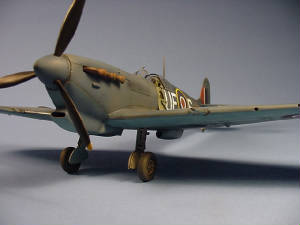
Arguments between historians and modelers are the rule when it comes to the Malta Spitfires and opinions concerning the
shades of gray and blue as well as underside colors differ. One thing that is certain from various autobiographies and
photos is the crews on Malta, the carriers delivering the Spitfires, and perhaps the depots on Gibraltar did not demur from
the task of overpainting these aircraft. One can only be 'proven wrong' in a choice few cases so if you're inclined
to build a Malta Spitfire then gather up your references and take your best shot!
Hopping over to Tunis, again we find Hasegawa's 1/48th Mk.Vb in the markings of AB502 of 244 Wing, flown by WC Ian Gleed
in the spring of 1943. This one wears the Dark Earth, Middlestone, and Azure Blue of the tropical land scheme.
Ian Gleed gained most of his 13-plus victories flying Hurricanes with No. 87 Squadron, particularly during the Battles of
France and Britain in 1940. He also shot down a handful of Ju-88s and other luftwaffe aircraft during the Channel War
prior to shipping out for North Africa. On April 16, 1943 Gleed lost his life in air combat against Bf109G's of JG-77
over the coast of Tunis near Cap Bon, most likely the victim of experte Ernst Wilhelm Reinert.
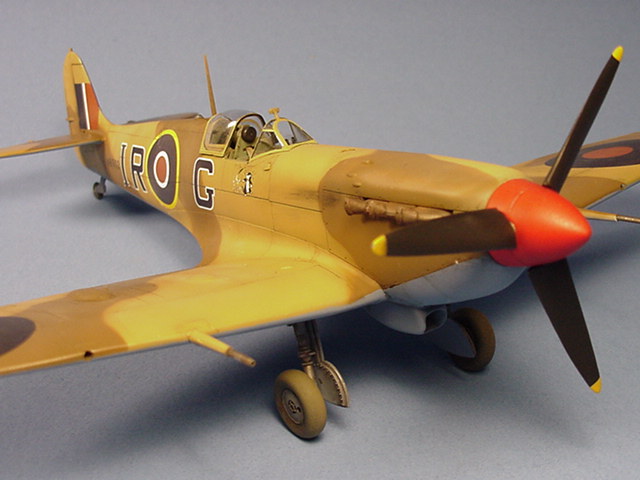
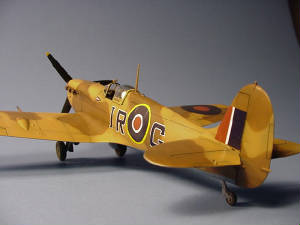
Paints used on this one (left and below) were Floquil's Dark Earth and Azure Blue, and Humbrol's RAF Middlestone.
Spinner was painted a mixture of Floquil British Scarlet and Modelmaster Insignia Red. Decals are from Victory Productions,
aftermarket add-ons include the Ultracast seat and exhausts, and a Cutting Edge gunsight.

Around the same time back on Malta, it's another Mk.Vb kitbash to arrive at a Mk.Vc from the Hasegawa kit.
This time it's EP829, flown by Sq Ldr John Joseph Lynch, No. 249 Squadron. Lynch was an Eagle Squadron volunteer hailing
from California who remained with the RAF after America entered the war. After serving with No. 71 (Eagle)
Squadron in 1941 and the first half of 1942, Lynch was posted to Malta the following November. During April 1943,
the luftwaffe was flying frantic resupply missions into Tunisia in a vain effort to save the Afrika Korps from ultimate defeat.
While flying EP829, Lynch shot down several Ju-52 transports, a Ju-88, and a CA-313 during this period over the Mediterranean
south of the island. One of these was a Ju-52 shot down on 28 April over the sea lanes between Sicily and Tunisia, judged
to be the 1,000th axis plane shot down by Malta's defenders.
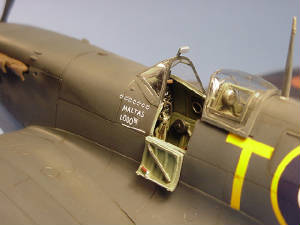 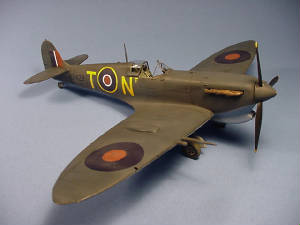 Referring to the descriptions of 249's Spitfires in Luca's bio "Five Up" as having been a "mesmerizing overall gray"
and also consulting photographs and several friends who know their Mediterranean Spitfires I decided to paint this one in
tropical land scheme with a dense Extra Dark Sea Gray from Floquil. Decals are from Victory Productions; Ultracast propeller,
spinner, exhausts, pilot door, pilot seat, gun bay hatch with large blister, cannons and stubs were used along with a Cutting
Edge GM-2 gunsight.
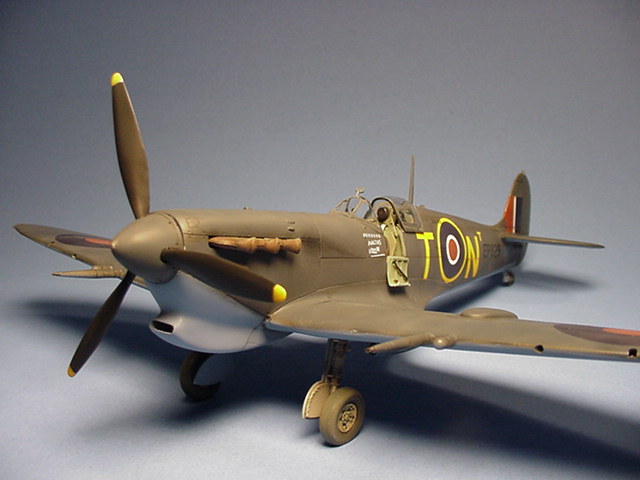
|
| I chose to ignore the decal instructions, and used extra dark sea gray on EP829... you be the judge! |
The only Hasegawa 1/48th Spitfire Mk.IX in my collection depicts one flown
by Flt.Lt. Otto Smik, an ace flying with No.312 (Czech) Squadron while based at Lympne in 1944. Paints used for the temperate
land scheme were the same as for McColpin and Witorzenc's Mk.V's above.
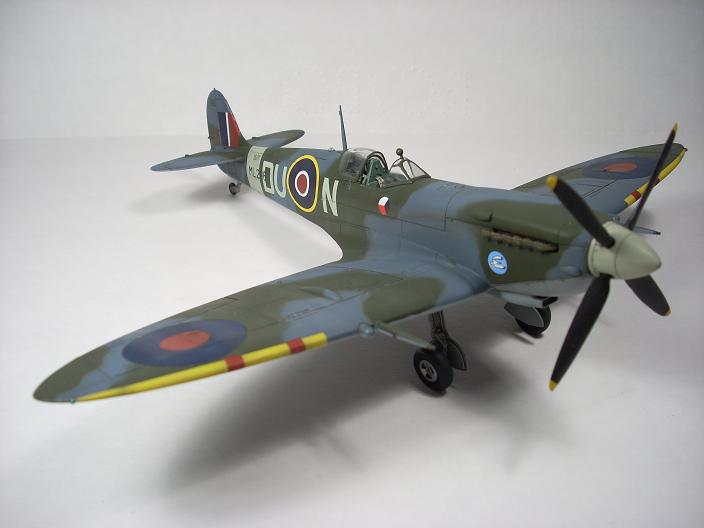
Smik was credited with 11+ victories, including the successful interception of 3 V-1 "buzz bombs". Unfortunately, Otto
Smik lost his life in action on August 18th, 1944. The Hasegawa kit, much maligned on the hobby forums, was a very enjoyable
build and I'm happy to have it among my Spitfire lineup. This build includes the spinner, propeller, exhausts, lower
cowl, wheels, and seat from Ultracast. Gunsight is from Cutting Edge.
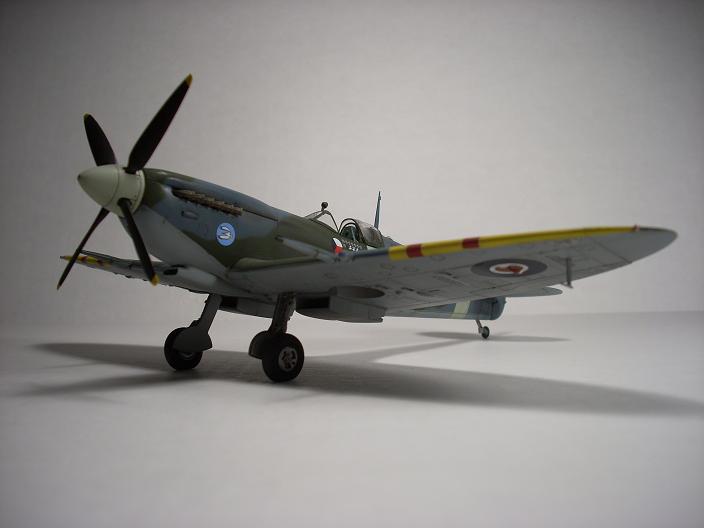
Curtiss Tomahawk Mk. II
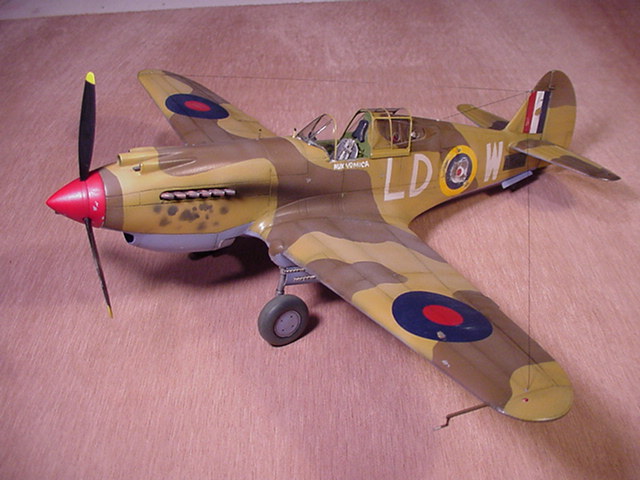
|
| For Sgt. Bob Whittle's Tomahawk IIB stenciled markings were combined with Aeromaster insignia |
Sgt. Bob Whittle flew Tomahawk IIB AM392 while assigned to No. 250 Squadron, stationed
at Sidi Haneish in western Egypt in the fall of 1941. Scoring 9 and 1 shared victories in North Africa, Whittle used
his "Nux Vomica" to down a Bf109 near Sollum on October 30th, 1941. AM392 survived operational use in the desert, serving
also with the RAAF's No. 3 Squadron prior to being struck off charge in July 1943. Sgt. Whittle returned to his native
Australia and was later posted to No. 86 Squadron RAAF. Flying the Kittyhawk III from Merauke, New Guinea, he claimed
a Zero and shared in the destruction of another Zero and a Betty bomber for his final victories on January 23rd, 1944.
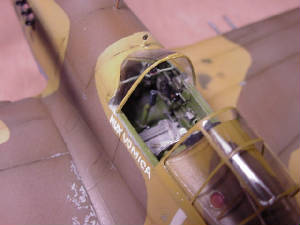
|
| Cutting Edge's cockpit set fit easily into the Hobbycraft kit |
The Hobbycraft P-36 was used with the Tom's Modelworks P-40B conversion and Cutting
Edge's interior set. The miserably inaccurate Hobbycraft pitot tube was replaced with Evergreen rod and a
piece of photoetch brass. Nux Vomica, latin for "deadly poison" was brush painted. After painting this
model in what I conjured for the American equivalents of British Middlestone, Dark Earth, and Azure Blue, further
research convinced me that the undersides of most Tomahawks sent to Africa were painted in the bluish-grey equivalent of RAF
Sky. Oh well, I can live with that.
Hawker Typhoon
Hasegawa's 1/48th scale Hawker Typhoon Mk. 1b appears below, in the markings
of Sq. Ldr. Roland P. Beamont while he was Officer Commanding, 609 Squadron, based at Manston in the spring of 1943.
Soon after starting operations, Typhoons began wearing yellow stripes above plus black and white stripes below to prevent
being mistaken for Fw190's by other fighter pilots and coastal defense gunners. Beamont served with distinction throughout
World War II, starting his combat career in Hurricanes with the AASF sent to France in an attempt to forestall her defeat
by the Wehrmacht. Having shot down at least 6 enemy aircraft, mostly in Hurricanes, Beamont was credited with the destruction
of 31 V-1 pulse jet powered Flying Bombs while flying Typhoons and Tempests.
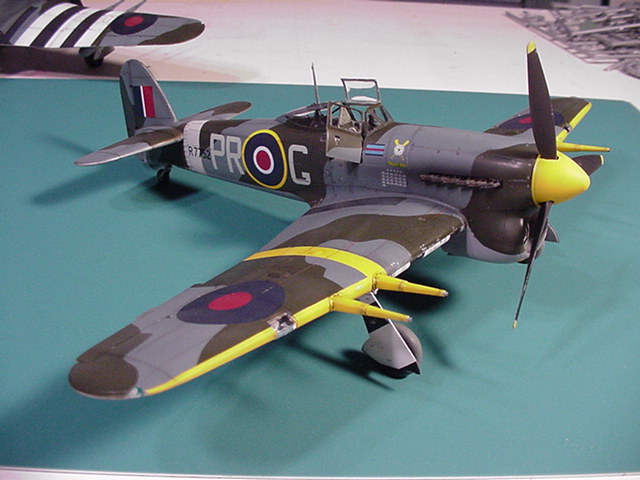
|
| As with Kepford's F4U, I used Techmod's superb decals for this one |
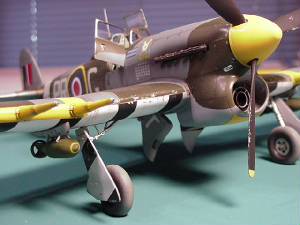
|
| On the car door Typhoons you can roll down the side windows |
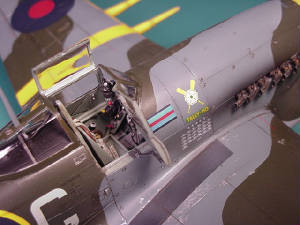
|
| Cutting Edge cockpit and photoetch door braces |
And now for the bubbletop Typhoon, here is Hasegawa's 1/48th scale offering
in the markings of Sq. Ldr. Basil G. Stapleton as it appeared upon his arrival in Normandy to join No. 247 Squadron in
the summer 1944 struggle to push the Wehrmacht out of France. In the following autumn his aircraft received a red spinner
and the invasion stripes were cut down so that they only showed on the underside. Stapleton rose rapidly to command
247 Squadron, performing ground attack missions from Normandy, through Holland, and into Germany itself. He was forced
to bale out behind the lines in December 1944 when airborne target debris struck his aircraft- and spent the last five
months of the war as a "guest" of the Germans in a succession of Stalags.
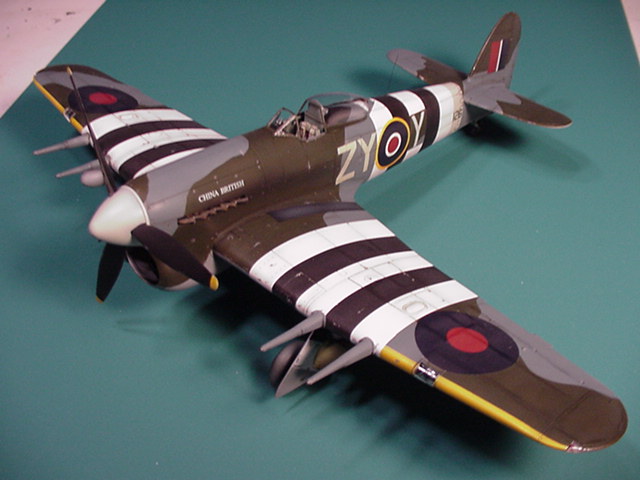
|
| More stripes, this time for Operation Overlord- the June 6th 1944 allied landings at Normandy |
During the tumultuous summer of 1940, B.G. "Stapme" Stapleton
served with No. 603 Squadron flying the Spitfire Mk. 1. During the Battle of Britain he was credited with 6 destroyed,
2 shared destroyed, 8 probably destroyed, and 2 damaged. For those who haven't had a chance to study the RAF system
of crediting combat claims, "probably destroyed" meant that although a target was seen to have been gravely damaged the pilot
was not seen to bale out nor was the aircraft seen to crash. All but three of his claims were against the Messerschmitt
Bf109E; given the 109's limited range and somewhat delicate nature I'd bet a pint of Guinness that the lion's share of
those 8 probables never made it back to Occupied France.
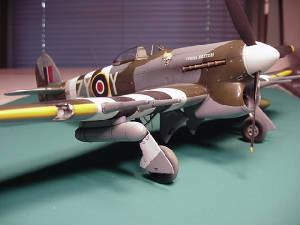
|
| Stapleton's noseart was rendered with paint and a technical pens |
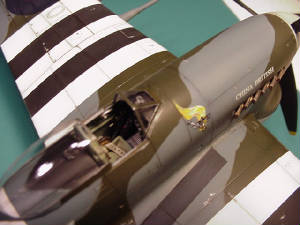
|
